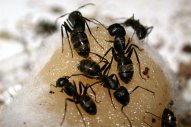- Spring Special - Save $50 Off All Wildlife Work
- Just Ask Us When Booking Your Service
Pest Control Treatment & Spraying for Insects
Bed Bug Treatment Bees-Wasps-Hornets Bumblebees Carpenter Bees Carpenter Ants Cockroaches Creepy Crawlies Fleas Pavement Ants, Ants SpidersWildlife Control for Birds, Mammals and Rodents
Bats House Mice and Rats Pigeons Raccoons Skunks Squirrels
Embo Pest Control will come and apply a residual product throughout the entire household as well as exterior perimeter treatment. We will also try to locate the ant nests by looking for potential nesting areas such as: decks, fences, and window and door frames... etc.
If damaged is noticed in any of these areas, we will apply pesticide to the colony or as close as possible to achieve the best possible results.

Carpenter Ants
Name: Carpenter Ants: Check rates page for pricing information and warranty.
Embo Pest Control's Procedure
- Spray inside and outside of premises to kill of as many forging ants as possible, to try to starve the colony out.
- Look for areas of investation and treat where possible.
- If problem persists within the interior household within 2-3weeks, please contact Embo Pest Control for re-application for treatment procedure.
Carpenter Ant Facts:
Carpenter Ants are beneficial insects. They have earned their own name by excavation of galleries in wood, together with finishing and cleaning of surfaces within wood. Their galleries open up damp and rotting wood so that it can be more quickly broken down by decomposers, such as any other insects or fungi.
They are also beneficial since they feed on many pests. They are the largest of our common ants, the brown or black workiers measuring from 6-13mm in length, while the queen may be more than 25mm long. In late spring, and early summer, mature Carpenter ant colonies produce winged adults. Outdoors, they nest in any wood that is in close contact to a moisture source, for example, stumps, landscape ties and wooden fence posts.
In buildings, they often make their nests between panelled doors, in wood cabinetry near dishwashers, in damp locations behind baseboards, fireplaces, window frames, and in basements and attics. Although they normally excavate their nests in wood, they may also nest in polystyrene insulation, fibreglass and other insulating materials which have not been treated to withstand attack. Carpenter ants will rarely do extensive damage to wood. They usually limit the size of the colony to the area of the damp wood. Several so-called satellite colonies may, however, be constructed in the same structure.
If carpenter ants are visible during the winter months within the household, we know for certain that there is a colony nesting and staying active for warmth from the household.
Carpenter ants do not eat wood, although they chew their way through wood, leaving frass particles(similar to sawdust). This is also another way to determine if your problem is carpenter ants and gives an easier way to determine the location of the nest due to the frass particles.

Home How It Works Rates About Contact
SERVICE AREAS
Guelph (519)279-6482Ancaster Barrie Binbrook Brampton Brantford Burlington Cayuga Cambridge Delhi Dundas Dunnville Etobicoke Fisherville Flamborough Gravenhurst Grimsby Guelph Hagersville Haldimand Halton Hills Hamilton Kingston Kitchener Long Point Milton Mississauga Niagara Falls Normandale Norwich Oakville Orillia Paris Port Credit Port Dover Port Rowan Port Ryerse Saint Catharines Simcoe Smithville Stoney Creek Streetsville Tillsonburg Thorold Toronto Turkey Point Waterford Welland

FREE Estimates - Locally owned and operated since 1989!
Toll Free 1-800-453-6040
All insects - Roaches, Bed Bugs, Wasps, Ants, Mice, Rats.
